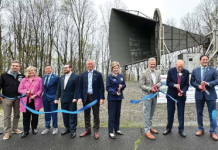By Allison Perrine
FORT HANCOCK – A New York-based development firm will soon bring to life a vision of what the future Fort Hancock could look like, an agreement with the National Park Service (NPS) states.
Officials fully executed a general agreement with Stillman Development International Jan. 1 which will allow the developer to create prototypes for two buildings along Officer’s Row, a site at the tip of Sandy Hook. The goal is to examine the models and determine if a larger development project is feasible, officials said during last Thursday’s virtual meeting of the Fort Hancock 21st Century Advisory Committee.
“This project is a very exciting and most unusual combination of civic, patriotic and commercial elements, and I am personally thrilled to find the balance between them,” said Roy Stillman, president of Stillman Development International, at the meeting. “We understand that we have a responsibility here and that responsibility comes from faith and reliance that you all have placed in us,” he said.
“We intend to apply ourselves diligently and with care and honor.”
Prototypes for the two buildings are part of Stillman’s larger plan to develop 21 structures at the site. He plans to construct 93 residential apartments spread out among the remaining buildings on Officer’s Row with short-term, long-term, corporate and seasonal leases.
At Building 80, he has plans for short-term rentals to support the nearby wedding chapel.
“We have committed to… forming a very professional design team of preservationists, structural engineers, architects and other related disciplines, in order to present design work to the relevant authorities,” said Stillman, calling it a “complex process” that is “intended to serve as a template.”
According to Jennifer T. Nersesian, superintendent of Gateway National Recreation Area, the first phase of the project is to work out the designs and determine “if there’s a project here or not,” along with the density, historic standards, capacity concerns and more. If it does work, “Stillman has first dibs on the rest of the buildings as one comprehensive project,” she said.
Outside of Stillman’s proposal, upgrades for other structures at the site are already in the works. According to Karen Edelman, business and agreements management specialist with the NPS, some leases have already been executed for Building No. 23, a barracks building; No. 53, which is open seasonally for coffee and grab-and-go food; No. 21, a duplex available for lodging; No. 52, open for residential and lodging use; No. 104, being rehabilitated as an office space; and No. 56, being rehabilitated by the Marine Academy of Science and Technology with the help of the county.
Most recently, Gateway executed a new lease for Building No. 36, the old mule barn. It will soon be utilized as a restaurant and bar and event space with outdoor seating. It is expected to be open year-round, Edelman said.
“It’s wonderful because we will have some dining options and entertainment options at Sandy Hook,” she said. “The lessee is also proposing to institute a shuttle service so that folks can get there from different areas of the park. We’re very excited because, as far as I know, it is meant to be up and running by the summer.”
Other buildings at the site are currently subject to letters of intent, including Buildings No. 24 and 25, two barracks which will be used as multiunit residential structures; No. 40, which will be used as a gymnasium; and Building 114, which will be used as an event space with dining and lodging.
Before work begins on a project, a series of considerations are made to study the existing and potential future environmental impacts, historical factors, habitats, visuals and more, according to Patti Rafferty, chief of resource stewardship at Gateway National Recreation Area, who explained the process in detail. She noted that the plans are reviewed and studied by several agencies, including the committee’s “working group.”
A sub-committee of the Fort Hancock Advisory Committee, the working group was developed after the Stillman proposal came in. It includes representatives of local environmental and historical organizations as well as a handful of advisory committee members. It was borne out of “a fair amount of controversy” around the plan when it was first introduced, particularly from some environmental groups with an interest in Sandy Hook, according to Nersesian.
“We want to understand those concerns as we’re moving forward with the leasing program and with anything we’re doing out at Sandy Hook,” she said. “I remain hopeful that there is a way to accomplish our historic preservation mission that remains sensitive to natural resources and all the other parts of what we’re trying to accomplish at Sandy Hook.”
And there are plenty of other projects in the works for Sandy Hook, Nersesian said. Pending congressional approval of the Great American Outdoors Act, Gateway will complete seawall repair work along Officer’s Row and rehabilitation of the chapel. Together, these projects would cost about $20 million.
“This is work on infrastructure that hasn’t had the investment in the maintenance it’s needed in years to get that back up to snuff,” she said.
Additionally, other projects include finalizing rehabilitation of the Guardian Park Restroom, a historic building and former morgue for the post; roofing upgrades; short-term chapel stabilization work; continued water filtration treatment plant upgrades; and more.
“We all know there’s a lot to do at Sandy Hook, but we’re trying to make some smart investments… and are getting a lot of support and funding right now to move some of these things forward which is really important,” she said. “It’s our hope that we can use many of these investments to help leverage the interest investment of private partners.”
During the public comment portion of the program, mediator Bennett Brooks read a letter from Monmouth Beach resident Sandy Van Sant stating that she was “very concerned” about the possibility of private development on Sandy Hook.
“As a lifelong environmentalist, registered nurse and retired public health official, I’m not against private-public partnerships in totality but do not believe this is a wise option,” she wrote.
She questioned whether the buildings “are worth saving at this point given the lack of protection from weather and decay” they have experienced over the past 20-plus years.
“I would like to hear about any evaluations that have been made looking at the effects of climate change and natural erosion there,” she wrote.
“Public support of national parks continues to be very strong. In fact, 8 in 10 voters would be prepared to pay more in taxes to preserve national parks. I hate to see a rush to give up public lands for short-term gain.”
The article originally appeared in the January 13 – 19, 2022 print edition of The Two River Times.















